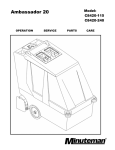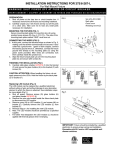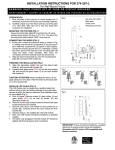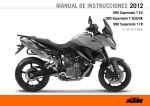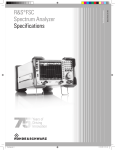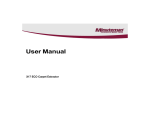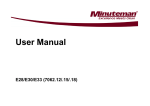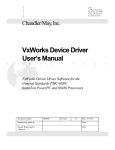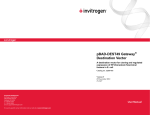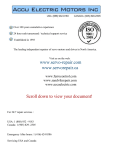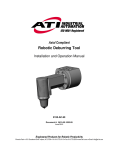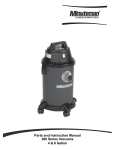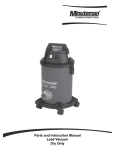Download 100D CTL/100T w/Flat Stock Cutter - Rapid
Transcript
Rapid-Air Operating Instructions C-T-L w/ 100D Series Servo Feed Control Ver. ‘C’ s/n 133095 & Later 4601 Kishwaukee Street, Rockford, IL 61109 815.397.2578 www.rapidair.com Thank you for purchasing a Rapid-Air Cut–to–Length (CTL) system. The system is configured from our proven line of servo feeds and stock cutters. Rapid-Air Corp. designed and built its first servo driven roll feed and cutter combination in 1994. As with the whole Rapid-Air product line there has been an ongoing program of product improvement. Our roots are in stamping and our engineering expertise is extensive. Many of our earliest products remain in use today, in small shops and large factories worldwide. Some of these products are still manufactured, with only slight modifications to the original design allowing for modern manufacturing technologies to be used in their production. All Rapid-Air products are built right here in our own U.S. factory. No inconsistent design, differing parts or sourcing problems. Just the same reliable quality, renowned support and lasting value you can always expect from Rapid-Air. TABLE OF CONTENTS Specifications ………………………………………………………………… Mechanical Set-up ………………………………………………………………… Servo Feed Operation ………………………………………………………… Troubleshooting .......................................................................................... Flat Stock Cutter Operation ………………………………………………… Warranty …………………………………………………………......…. – Electrical Schematic ……………………………..…………….…… – Electrical Assembly Drawing ……………………………..…………….…… – FSC6 Assembly Drawing ……………………………………………………….... – 106D Assembly Drawing ………………………………………...……… – FSC12 Assembly Drawing .................................................................... – 112D Assembly Drawing .................................................................... – FSC18 Assembly Drawing ……………………………………………....… – 118D Assembly Drawing ..................................................................... 2 4 5 13 14 15 16 18 20 22 24 27 29 34 1|Page . SPECIFICATIONS Mechanical Max Material Width: 106D / FSC6 112D / FSC12 118D / FSC18 Max Thickness Capacity at Full Width: 106D / FSC6 112D / FSC12 118D / FSC18 6” (152mm) 12” (304mm) 18” (457mm) 0.046” (1.17mm)* 0.060” (1.52mm)* 0.045” (1.14mm)* * based on low carbon steel, commercial grade Max Feed Roll / Cutter Blade Opening: 106D / FSC6 0.150” (3.81mm) 112D / FSC12 0.100” (2.54mm) 118D / FSC18 0.150” (3.81mm) Roll Position Repeatability: ± 0.0025” Roll Type: 8620 C.R.S. Hardened & Ground Blade Type: M2 DCF Tool Steel Heated & Tempered to 62-65 Rc Stock Entrance: Cascade Rollers and Edge Guides Standard Options: Pneumatic Operated Roller Release Special Rolls – Contact Factory Self-Centering Edge Guides Carbide Cutter Blades 2|Page SPECIFICATIONS cont’d Electrical Line Voltage: 120 VAC, 1Ø, 50/60 Hz Rated Input Current: 9.9 Amps Max Inrush Current: 10.0 Amps Max Operating Temperature: 30˚ C Ambient Controller: Trio Motion Coordinator MC302X AC Servo Drive: Kollmorgen AKD –B00606 Display: Beijer H-T60b-S Enclosure Rating: Dimensions: IP65 24” x 18” x 10” (610mm x 457mm x 254mm) Inputs: Use PNP sensor or isolated contact Min 3.5 VDC / Max 30 VDC Min 2 mA / Max 15 mA Outputs: Sourcing: 24VDC @ 250 mA max. Options: 460 VAC, 3Ø, 50/60 Hz AC Cooled Enclosure Adjustable Mounting Stand Pneumatic Shop Air Filtered and lightly lubricated Working Pressure 80-120 PSI Maximum Pressure 150 PSI 3|Page Mechanical Setup Installation Since the servo feed and the flat stock cutter have already been mounted on a common base no further mechanical component installation or alignment is required. The CTL cabinet may need to be leveled to steady the entire assembly or optionally it can be anchored to your shop floor. Four ½-13 threaded holes are provided in the cabinet base for this purpose. It will be necessary to bring a compressed air and an electrical service drop to the area you intend to locate the CTL. See the specification pages for requirements. Gear Train The gear train is located on the same side as the roll release handle. It is a non-lubricated gear train so it is essentially maintenance free. Pilot Release Stop Our 100D series servo feeds are equipped with a pilot release stop as standard. In a press feeding application higher speed applications may benefit from adjusting the pilot release stop. By limiting the amount the rolls can open, time is not wasted by the rolls traveling full open and close. The pilot release stop adjustment is mounted next to the roll pressure knob and should be set to let the rolls open about 0.005/.010” to free the material during piloting. In a CTL application there is no reason to adjust the pilot release stop. Roll Release Handle The roll release handle is located on the side of the servo feed. If the PILOT RELEASE STOP has not been set then the handle can travel ‘full stroke’ and lock in the fully open position. This is the max feed roll opening of 0.060”. If the pilot release stop has been set then the handle will only travel enough to open the rolls to the amount set by the pilot release stop. The handle will not lock in this position, do not force beyond this point. Roll Pressure The roll pressure knob is located on the entrance side of the servo feed and is a knurled knob with a locking nut located right behind it. It is positioned parallel to the inlet face and uses a compression spring for adjusting roll pressure. Adjust so there is only enough pressure applied to properly feed the stock. Exerting too much pressure can result in ‘fluting’ of the edges or cause camber. Entrance Guide The entrance guide’s adjustable rollers should be adjusted to maintain the incoming stock centered on the feed rolls. Similar guides are available as an option for the exit side of the feed rolls. By having a set of guides on each side of the servo feed the setup time for aligning the material in the feed is decreased considerably as you will know that the material is straight through the feed before entering the die. 4|Page SERVO FEED OPERATION When the control is turned on some of the components must boot-up, much like a computer. During this period the display will show a ‘clock’ so you can recognize the control is in the process of getting ready. If the control is turned on immediately after the incoming service is restored, you will notice a longer boot up time is required. The display is a touch screen. Touch the screen in the general area of an object when it is necessary to enter numbers, ‘push’ pushbuttons or reset values. The screen has a built in screen saver function whereby it blanks after a predetermined time of inactivity. Touch the screen anywhere to bring back it to life. On the right hand side of the display there are 5 programmable function keys. These keys have different functions depending on the active screen. The ‘F5’ key is typically the EXIT or CANCEL key. The keys are always active. If you forget a key’s function you can press the MENU button and the function key menu for the active screen will ‘slide out’. The slide out menu is also a touch key so you can either touch the appropriate menu choice or press the ‘F’ key itself. Once a choice is made the slide out menu will close. You can also close the slide out menu by pressing the MENU button a second time. As you become accustomed to the operation of the CTL you will probably find yourself calling for the slide out menu less and less. The CTL will power up with the last job used as the active job. This means there is no need to load the same job number day after day. 5|Page SERVO FEED OPERATION cont’d SPLASH SCREEN: Once the control is booted up and ready to go the Rapid-Air logo will be displayed. This is called the SPLASH screen. The SPLASH screen is the main menu. F1 – JOB SELECT Go to this screen to set up the desired job. F2 – AUTOMATIC Go to this screen to start making parts. F3 – MANUAL Go to this screen to manually control individual functions. F4 – JOB REVIEW Go to this screen to quickly see what the active job is and its parameters. F5 – ABOUT Go to this screen for information about the CTL. You can change to any screen listed, no particular order is required. For purposes of explaining the controls we will describe how to enter a new job number and the job parameters. A typical sequence would be: • JOB SELECT – Enter a job number • JOB CONFIG – After selecting a job number you are automatically sent to the JOB CONFIG screen to either confirm the job choice or to enter the new job parameters. You could also choose to go to the JOB CONFIG screen to edit an existing job’s values. • MANUAL – Allows you to test settings and position the material for production. You are automatically sent to this screen after the JOB CONFIG screen. • AUTOMATIC – Ready for production, waiting for the feed initiate signal. 6|Page SERVO FEED OPERATION cont’d JOB SELECT: This screen is used to define a new job, edit an existing job or recall an existing job. Up to 99 jobs can be created and stored. Until a valid job number is entered the ‘RECALL’, ‘NEW’ and ‘EDIT’ pushbuttons are not enabled. ‘F5’ is the only function key used on this screen. Use the ‘F5’ key to return to the SPLASH screen without changing any job information. RECALL: This pushbutton recalls a previously set up job and makes it the CTL active job. If any invalid job number is entered you will get a fault message. Simply acknowledge the message and try again. When the recall is successful you will be returned to the SPLASH screen. NEW & EDIT: Both of these pushbuttons will cause a new screen to appear allowing you to enter the job’s parameters. If you’ve forgotten what job numbers have been set up and you enter a used number and then push ‘NEW’ you will get a fault message. This action is intended to keep the operator from accidentally changing a stored job. Similarly, if you enter a job number that does not exist and try to ‘EDIT’ it you will get a fault message. Simply acknowledge the message and try again. 7|Page SERVO FEED OPERATION cont’d NEW / EDIT: On the ‘NEW’ job parameter screen, the feed length defaults to inches. Use the ‘F1’ & ‘F2’ to toggle between entering the length in inches or millimeters. On the ‘EDIT’ screen the feed length units will be whatever the job was originally defined as, but it may be changed the same way. Note, when changing between inches and millimeters on an existing job the previous length is not converted to the new units. For example, if the previously length was 1.25 inches and the units are changed to millimeters the length does not become 31.75 mm, it is now 1.25 mm. Enter the approximate number of cycles, the amount of time the cut off solenoid is energized and the required feed length. The controller will then compute the move parameters based on a standard trapezoidal move. If the move cannot be made with the given parameters a warning message will be displayed. Acknowledge the message and re-enter the parameters. If the move parameters are accepted but when the move is tested with material and it is apparent the move is too ‘hard’ so the rolls slip or other problems are caused, then edit the job and reduce the number of CYCLES per MINUTE. It will be trial and error to find the rate that works best for your particular application. The number of cycles per minute entered will only be an approximation of what is actually produced. Once a job is entered with valid parameters the operator will be returned to the SPLASH screen. 8|Page SERVO FEED OPERATION cont’d MANUAL: The manual mode is to aid in job setup and for maintenance. You can jog forward (JOG FWD) and you can jog reverse (JOG REV). The jog speed can be changed via the JOG SPEED (+) and JOG SPEED (-) pushbuttons. The speed can vary from 1 to 20. These numbers do not relate to anything like inches/sec, they are just a reference so you can return to a particular speed during future setups. When either jog speed change button is pushed the speed changes a small amount initially. The longer the button is held the more rapid the change becomes. The SINGLE CYCLE pushbutton will cause 1 feed length to be fed at the normal production speed and accel/decel rates. The JOG LENGTH pushbutton will jog forward just like the JOG FWD button except it will only feed up to the programmed feed length and then the POSITION REFERENCE indicator needs to be reset to 0.000 before it will jog again. Touch the POSITION REFERENCE ‘box’ to reset it. ‘F1’ will toggle the rollers open and closed if the servo feed is equipped with air operated rollers. ‘F2’ will cycle the cut off mechanism. It is possible to jog the servo feed via hardwired pushbuttons. If the CTL was not ordered with a remote jog pendant it is possible to field install JOG FWD and JOG REV pushbuttons. See page 2 of 2 of the included electrical schematic. Like the HMI jog buttons, the hardwired pushbuttons will only be active when the display is on the manual function screen. 9|Page SERVO FEED OPERATION cont’d AUTOMATIC: Two modes of operation are available in the automatic mode. One mode is continuous. In this mode the CTL will run until the operator stops the cycle. There is a TOTAL COUNT indicator that will indicate how many cycles have been run. This counter may be RESET at any time. When run in the continuous mode the screen changes and the BATCH start and count display will not be visible. The other mode of operation is in a batch mode. You can enter on the BATCH COUNT the number of pieces you want to make, start the machine and it will automatically stop after the count is complete. Once started in the batch mode the screen changes and the continuous mode start/stop pushbutton is not visible. The TOTAL count display remains visible allowing the operator to see how many cycles have happened and at the same time the BATCH counter will display the number of cycles remaining. The BATCH counter will reset automatically between batches but the TOTAL counter has to be manually reset. 10 | P a g e SERVO FEED OPERATION cont’d AUTOMATIC cont’d: When operated in the BATCH mode and the batch count is complete the CTL will stop cycling and the following screen will appear. When this screen is acknowledged you are returned to the start of the automatic function. At this point you can start another batch, change batch quantity and start another batch or operate in a continuous mode. The CTL control has an input dedicated for a TAUT stock sensor. A user supplied sensor wired to this input will cause the CTL to stop cycling if the input is triggered. The feed will continue to feed the length in progress when the input is triggered so it must be adjusted to allow enough stock in the loop to allow the completion of that feed length. 11 | P a g e JOB REVIEW When the CTL is powered up the last job used, edited or recalled is the active job by default. If you do not remember what that job is you can review it by pressing ‘F4- JOB REVIEW’ on the SPLASH screen. ABOUT If you contact Rapid-Air Corp. to request parts or seek other assistance with your CTL you may be requested to provide the Rapid-Air serial number or other programming information. You can find this information on the ‘ABOUT’ screen. Because the display or other parts may not be working when you need to contact us please record the information in the space provided below. Servo Feed Model Number _________________________________________ Serial Number (S/N) ___________________________________________ Shop Order Number (S.O.) ___________________________________________ Controller Prog. Number ___________________________________________ 12 | P a g e TROUBLESHOOTING If the servo drive faults out it is reported back to the controller as a general fault condition and the controller is not able to annunciate the specific cause. The operator interface will display the following message. There is a 2 character LED display on the front panel of the drive. The left character will be ‘F’ as in fault, and the right side displays the 3 digit fault number as follows: 1-9-1-[break] (for example). 13 | P a g e FLAT STOCK CUTTER OPERATION The cutter operates by air pressure down, spring return. Different material types and thicknesses will require different amounts of time for the cutter valve to be energized. For example; 0.010” foil will require less time for the blades to cut through the material then when compared to 0.030” cold rolled steel. Each job recipe allows for a different ‘CUT TIME’. If maximizing the cycle rate is not important you may find one CUT TIME works well for all of your setups. A suggested starting value is 0.250 second. Each blade has four cutting edges. When a blade dulls rotate it 90° for a sharp edge. When all four edges have been used, flat grind the large faces on both sides of the blade. After reinstalling the blades it may be necessary to adjust the clearance between the blades. Blade Adjustment - The upper blade may be lowered manually with the eccentric cam located at the top center of the cutter. The purpose for this manual operation is for horizontal blade clearance adjustment. Blade clearance affects the quality of the cut. The CTL is shipped with the cutter’s blades clearance set at the factory. To adjust the blade clearance: • Cam the upper blade down. • Loosen lower blade holder lock screws. * • Move lower blade in or out with knurled knobs. ** • When desired clearance is achieved, lock lower blade holder screws. • Check adjustment by manually cutting bond paper. The upper blade is mounted with a 2° shear angle. * FSC6, item #71 FSC12, item #51 FSC18, item #85 ** FSC6, item #26 FSC12, item #29 FSC18, item #31 14 | P a g e WARRANTY Warranty Terms & Conditions ALL SALES BY THE COMPANY ARE MADE SUBJECT TO THE FOLLOWING TERMS AND CONDITIONS. PLEASE READ. Warranty – The Company warrants for a period of one year from the date of shipment by the Company that the product shipped is free from defects in material and workmanship. THIS WARRANTY IS EXCLUSIVE AND IN LIEU OF ALL IMPLIED WARRANTIES IN LAW, INCLUDING MERCHANTABILITY. The Company obligation under this warranty is limited to repairing or replacing, F.O.B. Rockford, IL, any part or parts proved to have been defective when shipped. In no event shall the Company be liable for special or consequential damages. Provisions set forth in specifications are descriptive and subject to change and are not intended as warranties. Customer License Agreement Rapid-Air reserves the rights in its software. The software program is licensed by Rapid-Air to the original purchaser of the equipment which contains the software for use only on the terms set forth in this license. You may use the program only on the programmable servo controller furnished with the system and only in conjunction with the servo feed supplied with the system. You may not without expressed permission from Rapid-Air: A. Copy, distribute, or document the program for others. B. Modify or merge any portion of the program for use on non-compatible hardware. C. Make alterations to the program. 15 | P a g e 16 | P a g e 17 | P a g e 18 | P a g e 19 | P a g e 20 | P a g e 21 | P a g e 22 | P a g e 23 | P a g e 24 | P a g e 25 | P a g e 26 | P a g e 27 | P a g e 28 | P a g e 29 | P a g e 30 | P a g e 31 | P a g e 32 | P a g e 33 | P a g e 34 | P a g e 35 | P a g e




































